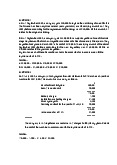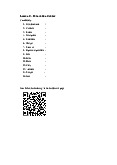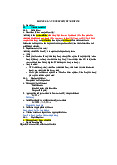





Preview text:
1. Shares which have been issued and for wich
13. -Things which belong to a business which
the company is demending payment
have the value or power to create money,
Called – up share capital such as machinery
2. Money earned from a company's normal
-Things which a person or company owns
activities, not including exceptional items
and which are of value to the owner Operating expenses assets
3. amounts of money owed by a business to a
14. money which is lent or borrowed supplier or lender loans liabilities
15. Profit relating to a company's normal
4. official organizations which represent
activities of providing goods or servcies,
people of a particular profession before tax is deducted accountancy bodies operating profit
5. the capital that a company has from shares
16. the part of a company's profits from rather than from loans
previous years which have not been paid to equity investors
6. -The value that a company has in addition to reserves
its assets, such as a good reputation with its
17. Costs relating to a company's normal customers
activities of providing goods or services
-the total value of a company minus the net Operating expense value of the tangible assets
18. when a company’s financial records are goodwill
officially checked because illegal activity is
7. an accountant working in this areas acts for suspected
a person or company that is no longer able forensic accounting
to pay their debts or a company whose liabilities exceed its assets
19. A part of the profits of the company for a insolvency
particular period of time that is paid to
8. less than half a company's shares, or fewer
shareholders for each share that they own
shares than the largest shareholder dividend minority interests
20. -The gradual loss in value of a fixed asset
9. prepare for a company’s financial
that wears out over a number of years or
information in order to calculate the needs to be replaced regularly
proportion of their profit which they must
-The process to reduce the value of a fixed pay to their government
asset to zero, over a specified number of tax accounting years (verb: to depreciate)
10. official body of auditors, who check that a depreciation
company’s financial report is true and honest
21. business activity in which two or more chamber of auditor
companies have invested together
11. to move something to a different place or joint venture position
22. -money set aside for a future expense (such shift
as debts which a company's customers fail to
12. in the UK, a person who has finished three pay).
years of work and training and passed an
-the inclusion in the accounts of amounts
examination to become a member of the which may arise in the future
Institute of Chartered Accountants provisions chartered accountant
23. the opinion that people have of someone or
something, based on past behavior or character reputation Back-office manager
24. a person or an organization who is chosen
38. Employees of a company who are
by the government to be responsible for
responsible for inspecting its accounts
making sure that an industry or system work Internal auditors legally and fairly
39. People employed by an outside firm of regulator
accountants and hired by a company to
25. one of the standards created by the inspect its accounts.
International Accounting Standards Board, External auditors which
40. An asset which does not have a physical
explains how company accounts must be
nature (such as a trademark or a patent). recorded or shown Intangible assets IFRS
41. The holding company owns a minority
26. Money paid out to shareholders
interest (less than 50%), but the accounts are Dividend nevertheless consolidated.
27. Coins, bank notes, or something that can be
Consolidated affiliates (củng cố/ liên kết chi easily exchanged for these nhánh) Cash
42. The total legal obligations of a company to
28. Building and equipment for manufaturing pay other parties. Plant
Total liabilities (tổng nợ phải trả)
29. - Writing an intangible asset off over a
43. The ordinary shares held by the owners, who number of years
therefore are the last to receive their money
-The process to reduce the value of an
back in the event of liquidation.
tangible to zero , over a specified number of
Common stock (cổ phiếu phổ thông): years (verb: to amortize)
44. Amounts that will be collected in the normal Amortization
course of business within one year.
30. Purchase price minus real value of assets Current receivables Goodwill
45. Profit which is not paid out to shareholders
31. Increasing by successive additions
in the form odd dividends, but instead is Cumulative
kept by the company to reinvest or pay off
32. Reduction in value due to wear and tear debts. Depreciation
Retained earning (lợi nhuận giữ lại) 33. Money that is owed
46. The amounts affecting common Debt
stockholders, but not from movements in the
----------------------------------------------------------
stock of the company. (e.g. currency
34. Accountants who are studying for translation adjustments). professional examinations. Accumulated gains (lợi nhuận tích lũy) Trainee accountants
47. The current assets divided by the current
35. Administrative staff responsible for liabilities
processing the records of a business’s
Working Capital (vốn lưu động) financial activities.
48. Net income plus interest expenses divided Bookkeepers by total assets
36. An accountant speciallizing in a company’s
Return on Assets (Tỷ suất sinh lợi trên Tài tax affairs sản) Tax accountant
49. Total assets divided by total liabilities
37. Person in charge of the staff responsible for Debt / Assets ratio
giving administrative support to the Finance department
50. The amounts that a person or organization
52. Another word for purchase. Normally used
owes to someone else in the normal daily
for very large amounts, such as buildings, business
factories, or another company (verb: to Accounts payable acquire)
51. The amounts that a person or organization Acquisition
is owed in the normally daily business, i.e.
53. A person or company wich is in some way
excluding loans and liabilities connected to another Accounts receivable Affiliate
54. The professional body of accounts in the Creditor USA
65. An amount which has to be paid to another
AICPA (American Institue of Certified Public
party (see also: to service debt) Accounts) Debt
55. A written statement showing 1)the amount
66. The inclusion in the accounts of amounts
of money and property a company has and
which will have to be paid in the future, but
2)the money received from shareholders and
which are based on current transactions. creditors Deffered Balance sheet
67. Another word for the sale of an asset
56. The top management of a company Diposition Board (of Direcors)
68. The process of checking the finances and
57. The fixing of the amounts to be spent in the
contracts of a company before the purchase
future. Also, the official statement showing
of assets or shares, to ensure all relevant these amounts information has been given. Budget Due diligence
58. When a company spends money on
69. The money spent on buying assets, which
something which will last for more than one
will then be included in the Balance sheet
year. This amount is normally put into the Expenditure Balance sheet
70. When used as a verb, this word means that Capitalization
am amount of money spent by a company
59. The title given to state-recognized
can go directly into the Profit and Loss
accountants in the United States of America Statement
CPA (Certified Public Accountant) To expense
60. Not telling others about information which a
71. The proportion of debt and equity ownership
business partner or client tells you in company of an asset. Confidentiality Gearing
61. The idea that accounts should be prepared
72. These are the rules which accountants are
on the same basis from one year to the next
required to follow when preparing financial Consistency principle
statements, which are not written into law
62. The process of including the figures of
GAAP (Generally Accepted Accounting
subsidiaries and affiliates in the accounts of Principles) a holdin company
73. The idea that financial information can only Consolidation
be reported correctly on the basis that the
63. The manipulation pf figures in the accounts,
company will be able to operate in the
designed to give a better result for the future. company Going concern principle Creative accounting
74. The company wich owns the shares in all the
64. A person of organization to whom money is other companies in a group owed Holding company
75. Used to describe the process of reducing the
Off balance sheet accounting value of an intangible asset
88. A company which owns most of the shares To impair
in another company (see also: subsidiary)
76. Currently the International Financial Parent company Reporting Standards
89. The idea that financial information should IAS
be reported conservatively, so that it is not
77. The set of standards created to unify
possible that the overall value of a company
accounting practices in the world. Replace is overstated
the former International Accounting Prudence principle Standards
90. A mathematical calculation which compares IFRS one amount to another
78. The goods which a company produces, but Ratio which have noy yet been sold
91. Cost to fix an assets (such as a machine), or Inventory
the normal cost needed to keep the asset
79. A legal contract to rent assets from the working properly
owner, often over long periods of time and Repair and maintenance
with the possibility to buy the assets at the
92. The estimated value of an asset at the end of end of the rental period its useful life Leasing Salvage value
80. The amount of money or the value of
93. The sales valude of an asset when it can no
something, which a person or organization longer be used
owes to someone else. For insurance Scrap value
matters, “liability means the responsibility
94. To pay the interest and capital repayment in to pay the cost of an accident
accordance with the loan contract Liability To service debt
81. The dissolving of a company which can no
95. -Another word for the shares of a company longer pay its bills
-The inventory of a company, i.e., the goods Loan which have not been sold
82. The difference between the sales value and Stock
the direct cost of producing an item
96. A company which is owned or controlled by Margin
another company (see also: parent company)
83. The idea that amounts should be recorded at Subsidiary
the time they occur, not when cash is paid or
97. An official document sent to the tax received
authorities which states profit or loss, and Matching principle
used to calculate how much tax has to be 84. The end date of a contract paid Maturity Tax return
85. When two organizations come together to
98. The process of checking a random sample of
create one new company (verb: to merge)
a list of items, to gain assurance that the Merger
complete list is correctly reported
86. A shareholding of less than 50% in another Test basis company
99. The increase (decrease) in value of an asset Minority interest which has not yet been sold
87. The structurin of certain transactions which Unrealized gain (loss)
might allow the company to leave large amounts out of the accounts Bài 2:
Investors in companies want to know how much the companies are worth, so
companies regularly have to publish the value of their assets and liabilities. Companies also have to
calculate their profits or losses: their managers need this information, and so do shareholders, bondholders and the tax authotities .
Companies can choose their accounting policies - their way of doing their accounts.
There are a range of methods of valuation - deciding how much something is worth -
and measurement - determining how big something is - that are accepted by law or by official
accounting standards . In the USA, there are Generally Accepted Accounting Principles (GAAP). In most
of the rest of the world there are International Financial Reporting Standards (IFRS), set by the
International Accounting Standards Board. These are technical rules or conventions - accepted ways of doing things that are not written down in a law.
Although businesses can choose among different accounting policies, they have to
be consistent which means using the same methods every year, unless there is a good
reason to change a policy: this is known as the consistency principle. The policies also have
to be consistency principle or revealed to the shareholders: the Annual Report will contain a 'Statement of
Accounting Policies' that mentions any changes that have been made. This enables shareholders to compare profit and values with those of previous years.
Areas in which the choice of policies can make a big difference to the final profit
figure include depreciation - reducing the value of assets in the company's accounts, the valuation of
stock or inventory, and the making of provisions -amounts of money deducted from profits - for future pension payments.
As there is always more than one way of presenting accounts, the accounts of
British companies have to give a true and fair view of their financial situation - meaning
there are various possibilities - rather than the true and fair view - meaning only one is possible. Bài 3:
IAFP – Your passport to the future
All organizations around the world, large or small , need someone who can understand and manage
their finances . So a career as an accountant will give you excellent job prospects. With the
right qualification you can work in many different countries. Qualified accountants are always in demand
from Australia to Azerbaijan. The question is not Where can I go? But Where do I want to go?
Whatever your career goals , you need to think seriously about a professional accountancy
qualification. There are many to choose from –and the choice you make now will affect your career
options in the future. A good qualification is your passport to a variety of career oppoturnities .
We offer first-class qualifications to ambitious, capable, and hardworking people who are looking for
a rewarding career in accountancy, finance and management. Our qualifications are respected worldwide
by employers, governments and the accountancy profession itself.
TIẾNG ANH CHUYÊN NGÀNH BUỔI 7 (17/10)
1. Cost accounting is about manufacturing and sales costs.
2. Management accountants prepare information which manegers use to make decisions
3. Management accountants sometimes suggest ways to improve financial preformances
4. Management accountants may also analyse non-financial data
5. Management accountants are normallyfor internal use only


